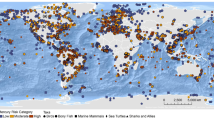Abstract
The distribution of mercury in the muscle and other tissues was determined in 23 species of fishes and invertebrates. This study reveals species-specific patterns of mercury accumulation in the muscle of tuna and alfonsino. Consistently high levels of total mercury were found in Beryx splendens (0.78±0.56 μg/g), Atlantic Thunnus thynnus (0.42±0.06 μg/g), Pacific T. thynnus (0.59±0.34 μg/g), Thunnus obesus (0.98±0.34 μg/g), Makaira nigricans (0.56±0.05 μg/g), Tetraptrus audax (0.51±0.08 μg/g), and Xiphias gladius (0.47±0.24 μg/g). Other fish species had lower levels of total mercury or methylmercury in muscle than the maximum permitted level of mercury in fish in Japan (0.4 μg/g). Total mercury and methylmercury levels in the muscles of T. thynnus, T. obesus, and B. splendens were closely correlated with body weight.
Similar content being viewed by others
References
Braune BM. Mercury accumulation in relation to size and age of Atlantic herring (Clupea harengus harengus) from the southwestern Bay of Fundy, Canada. Arch. Environ. Contam. Toxicol. 1987; 16: 311–320.
Burger J, Gaines KF, Gochfeld M. Ethnic differences in risk from mercury among Savannah River fishermen. Risk Anal. 2001; 21: 533–544.
Lacerda LD, Bidone ED, Giumaraes AF, Pfeiffer WC. Mercury concentrations in fish from the Itacaiunas-Parauapebas River system. Carajas region. Amazon Ann. Acad. Bras. Sci. 1994; 66: 373–379.
Park JG, Curtis LR. Mercury distribution in sediments and bioaccumulation by fish in two Oregon reservoirs: point-source and nonpoint-source impacted systems. Arch. Environ. Contam. Toxicol. 1997; 33: 423–429.
Bjornberg KA, Vahter M, Petersson-Grawe K, Glynn A, Cnattingius S, Darnerud PO, Atuma S, Aune M, Becker W, Berglund M. Methyl mercury and inorganic mercury in Swedish pregnant women and in cord blood: influence of fish consumption. Environ. Health Perspect. 2003; 111: 637–641.
Schober SE, Sinks TH, Jones RL, Bolger MP, McDowell M, Osterloh J, Garrett ES, Canady RA, Dillon CF, Sun Y, Joseph CB, Mahaffey KR. Bloodmercury levels in US children and women of childbearing age, 1999–2000. JAMA 2003; 289: 1667–1674.
Jacobson JL, Jacobson SW, Humphrey JB. Effects of in utero exposure to polychlorinated biphenyls and related contaminants on cognitive functioning in young children. J. Pediatr. 1990; 116: 38–45.
Schant Z. SL. Developmental neurotoxicity of PCBs in humans: what do we know and where do we go from here? Neurotoxicol. Teratol. 1996; 18: 217–227.
Sparks P, Shepherd R. Public perceptions of the potential hazards associated with food production: an empirical study. Risk Anal. 1994; 14: 799–808.
Graff RD, Philbert MA, Lowndes HE, Reuhl KR. The effect of glutathione depletion on methyl mercury-induced microtubule disassembly in cultured embryonal carcinoma cells. Toxicol. Appl. Pharmacol. 1993; 120: 20–28.
Dey PM, Gochfeld M, Reuhl KR. Developmental methylmercury administration alters cerebellar PSA-NCAM expression and Golgi sialyltransferase activity. Brain Res. 1999; 845: 139–151.
Weihe P, Grandjean P, Debes F, White R. Health implications for Faroe islanders of heavy metals and PCBs from pilot whales. Sci. Total Environ. 1996; 186: 141–148.
Grandjean P, Weihe P, White RF, Debes F. Cognitive performance of children prenatally exposed to ‘safe’ levels of methylmercury. Environ. Res. 1998; 77: 165–172.
Boush G, Thieleke JR. Total mercury content in yellowfin and bigeye tuna. Bull. Environ. Contam. Toxicol. 1983; 39: 291–297.
Arima S, Umemoto S. Mercury in aquatic organisms — II. Mercury distribution in muscles of tunas and swordfish. Bull. Jpn. Soc. Sci. Fish. 1976; 42: 931–937.
Kamps LR, McMahan B. Utilization of the Westoo procedure for the determination of methyl mercury in fish by gas-liquid chromatography. J. Assoc. Off. Anal. Chem. 1972; 55: 590–595.
Burger J, Gochfeld M. Mercury in canned tuna: white versus light and temporal variation. Environ. Res. 2004; 96: 239–249.
Plessi M, Bertelli D, Monzani A. Mercury and selenium content in selected seafood. J. Food Composition Anal. 2001; 14: 461–467.
Nakagawa R, Yumita Y, Hiromoto M. Total mercury intake from fish and shellfish by Japanese people. Chemosphere 1997; 35: 2909–2913.
Storelli MM, Stuffler RG, Marcotrigiano GO. Total and methylmercury residues in tuna-fish from the Mediterranean Sea. Food Additiv. Contam. 2002; 19: 715–720.
Harris HH, Pickering IJ, George GN. The chemical form of mercury in fish. Science 2003; 301: 1203.
Nara M, Baba K, Yamada N, Matsuoka T. Mercury contents in Beryx splendens Lowe and Sebastes matsubarai Hilgendorf. Bull. Shizuoka Pref. Fish. Exp. Stn. 1976; 10: 91–96.
Takeda M, Ueda T. On mercury and selenium in tuna fish tissues — VII. Selenium level in muscles of yellowfin tuna and in livers and spleens of tuna and marlin. J. Shimonoseki Univ. Fish. 1978; 26: 267–279.
Piotrowski JK, Trojanowska B, Sapota A. Binding of cadmium and mercury by metallothionein in the kidneys and liver of rats following repeated administration. Arch. Toxicol. 1974; 32: 351–360.
Ikenouye H. Age determination by otolith of a Japanese, Beryx splendens with special reference to growth. Tokyo Univ. Fish. 1969; 55: 2–10.
Author information
Authors and Affiliations
Corresponding author
Rights and permissions
About this article
Cite this article
Yamashita, Y., Omura, Y. & Okazaki, E. Total mercury and methylmercury levels in commercially important fishes in Japan. Fish Sci 71, 1029–1035 (2005). https://doi.org/10.1111/j.1444-2906.2005.01060.x
Received:
Accepted:
Issue Date:
DOI: https://doi.org/10.1111/j.1444-2906.2005.01060.x




